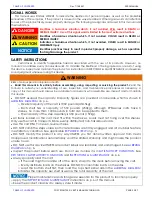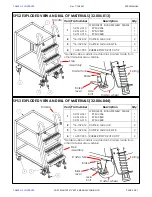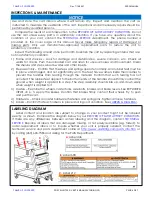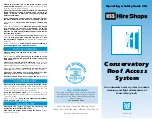
Rev. 7/16/2021
SPS3 MANUAL
COPYRIGHT 2021 VESTIL MANUFACTURING CO. PAGE 5 OF 7
RECORD OF SATISFACTORY CONDITION (THE “RECORD”)
Record the condition and appearance of each of the frame members (steps and step
assembly, shelves, handles), casters and caster receivers, rubber feet, springs, and all fasteners
(bolts, nuts, etc.) before putting the cart into service. Apply both caster brakes. Confirm that
brakes firmly contact their wheels. Try to push and pull the cart. Describe the effort required to
move the cart while the brakes are applied. Step on the bottom step. Describe how the handles
react, i.e. slide through the handle brackets until rubber feet contact the floor. Handles should
slide freely through the handle brackets. Describe sounds heard as the handles slide. Step off of
the bottom step. Describe how the springs recoil and lift the handles. Thoroughly photograph the
cart from multiple angles. Include close range photographs of the rubber feet, caster wheels,
caster forks, brakes and brake levers, caster mounting hardware, labeling, welds that connect
steps to handles, handles and handle brackets. Add the photographs to the record. Collect all
photographs and writings in a single file. This file is a record of the cart in satisfactory condition.
Compare the results of all inspections to this RECORD to determine whether the cart is in
satisfactory condition. Do not use the cart unless it is in satisfactory condition. Purely cosmetic
changes, like damaged paint or powdercoat, are not changes from satisfactory condition.
However, touchup paint should be applied as soon as damage occurs.
USING THE CART
WARNING
Improper use could result in serious personal injuries.
•
Do not stand on the top shelf.
•
Do not lean or reach beyond the profile of the cart because the cart might tip and fall over.
•
Do not exceed the capacity of the cart or of the ladder. The capacity (in pounds) per shelf is
550 lb. (250kg). Overall capacity of the cart is 1000 lb. (454.5kg). [
NOTE:
Although each shelf can
support up to 550 pounds and there are 3 shelves, no more than 1,000 pounds in total can be
applied to the shelves.] The capacity of the step assembly is 350 lb. (159kg).
•
Each cart receives label 446, which provides the capacity of the cart. See
on p. 6. The capacity figure provided on label 446 indicates the
net capacity
of the cart, i.e. the
combined weight of everything applied to cart. The combined weight must be less than or equal
to the capacity of the cart.
Review the
SAFETY INSTRUCTIONS
on p. 2 before using the cart. Inspect the cart before each
use for damage such as significant wear, deterioration, or rusting/corrosion. Pay particular
attention to the condition of the rubber feet! DO NOT use the cart unless all 4 feet are in
satisfactory condition. Tighten loose nuts. If a lock nut has been partially or completely
unfastened, it must be replaced with a new lock nut.
Make sure there are no children in the area
where the ladder is used
or stored
.
ONLY use the cart on even, level, improved surfaces (concrete or asphalt).
Never use the cart
on inclined surfaces. Only climb the steps if they are clean and dry.
ALWAYS lock both swiveling casters (located under the bottom step) before climbing the steps.
Lock each caster by pressing down on the brake lever. A brake should press firmly against the
surface of its caster. The cart will
resist
movement while the brakes are applied. However, the
brakes do not
prevent
the cart from moving. If the cart needs to be immobilized, block/chock the
wheels or enlist a coworker to hold the cart. No more than 1 person at a time should climb the
steps. The capacity of the step assembly is 350 pounds (159kg).
Step onto the bottom step. The handles should slide through the handle brackets and bring the
rubber feet on the bottoms of the handles into solid contact with the ground. The rubber feet
provide additional resistance the movement while the caster brakes are applied.
Load items onto the shelves of the carts. Items should fit entirely within the shelves without
hanging over the sides. Center and evenly distribute items on the shelves. Load the cart from the
bottom up, i.e. fill the lowest shelf first; then the intermediate shelf; then the top shelf.
!














